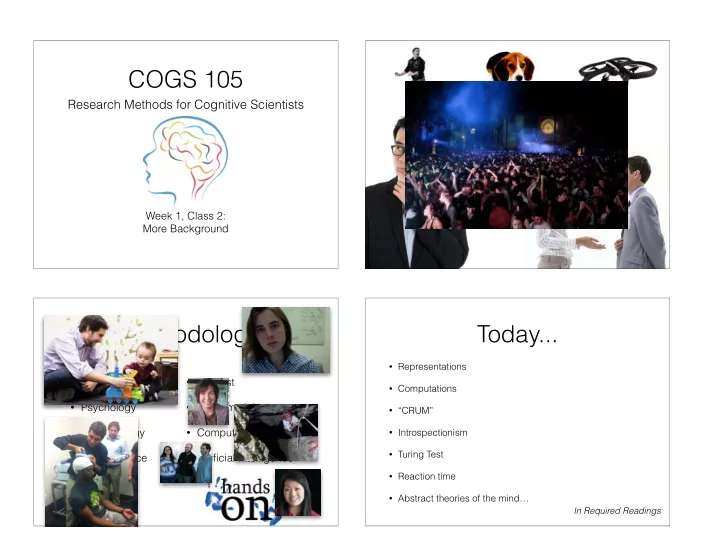

COGS 105 Research Methods for Cognitive Scientists Week 1, Class 2: More Background Multi-Methodological… Today... • Representations • Philosophy • Linguist • Computations • Psychology • Mathematician • “CRUM” • Anthropology • Computational scientist • Introspectionism • Turing Test • Neuroscience • Artificial Intelligence • Reaction time • Biologist • Abstract theories of the mind… In Required Readings
Today... Behavior... CLASSICS Representation Behavior... • Broad technical term that has a diversity of meanings • E.g., belief or memory • E.g., accessed word that is active in mind • E.g., an “interpretation” of an event, or visual stimulus • “Internal” state that “stands for” things • “Informational state” used by the mind.
Computation • You can “compute over representations.” You do things with them. • Accessing a memory • Storing a new word you just learned • Decompose word into letters... • Therefore you go from one representation to another “computer metaphor of the mind” through computation • decompose(car) -> c, a, r “CRUM” Introspectionism • Computational-representational understanding of • Argues that we have rich mental life that can be mind analyzed by getting people to reflect on it. “Reflection” will reveal this “mental world.” • You have symbols, representations, etc. in your • In US: Edward Titchener, Cornell University, late mind that stand for things 1800s/early 1900s. • You think by manipulating these symbols according • Lasted into the 1920s: hard to repeat experiments, to particular rules, operations, etc. hard to control, etc. • In other words: You are a computer, and your • Gave way to behaviorism (more on this later). thought processes are just computer programs
Behaviorism Revolution? • Here is the received history of cognitive science: • Behaviorists took over psychology after introspectionism failed (Watson, Skinner). (They dominated from about 1920 into the 1960’s.) • Behaviorists insisted that theories with “mental Chomsky’s Famous Review stuff” are invalid, because mentality is fundamentally unobservable... Gardner’s Hexagon Turing Test • Is a machine “intelligent”? • Is a program “intelligent”? • Predicted and very closely related to the sophistication of “chat bots” used for fun and in growing ways by companies. • http://rebot.me/harrystyles
Obviously… Measure Mental Timing! • You can’t find out everything about mental processes by just “talking” to human participants in experiments. • We should also develop methods that let us “peer into the mind.” • E.g.: Reaction time is nearly the behavioral bread and butter of cognitive psychology. RT < RT “Mental Chronometry”; since the late 1800s! Reaction time (RT) How to use RT • In an experiment, RT is often measured in two or more • Time required to go from seeing a stimulus (e.g., a ways . Then you compare average RTs. picture prompt) to making a response... often measured in milliseconds,1000 ms = 1 s. • E.g., are people faster to respond to positive vs. negative words? • 1) Create list of words. • 2) Have 3 words that are negative, 3 positive. • 3) Present to subjects, record RT. • 4) Average the RT’s in each word condition.
Word stimuli Example: Simple response • sickness 453 ms • smiles 462 ms • On the next screen you will see words pop up. 421 ms • happy • Tap your desk with the palm of your hand when a 512 ms 400 ms word appears. • sadness 347 ms 353 ms • harm 312 ms • money Another example... Word stimuli • roses • It takes a step of computation in order to decide to • injury respond than just responding to anything. • On the last slides: Simple response (simple • poverty reaction time to a stimulus). Aka, “respond to • playground anything as it appears.” • Now, let’s do this differently: Respond only to • love positive words . • dreary
Another example... Word stimuli • broken • It takes another step of computation in order to • rotten decide which response to make than just deciding about a single response. • delicious • On the last slides: 1 decision only. Aka, “recognize • humor positive words.” • Now, let’s do this differently: Respond with the right • puppies hand to positive, left to negative. • heaven Abstract theories... Theory of simple responses • Simplified “on paper” draw-up of how a system is working without regard to the “physical” stuff that is doing it. detection recognition selection • Many “classical” cognitive science/psychology theories were abstract by being “box and arrow models” of the mind. < < RT RT RT • Examples: logic, rules, analogies are often used in stage-based theories (reading #2)…
process Trebek’s Reaction time (RT) words assemble into • Time required to go from seeing a stimulus (e.g., a sentences picture prompt) to making a response... often interpret measured in milliseconds (1/1000ths of a second). meaning access memories confirm knowledge or not respond now Respond When However… a “D” Is Present • We now know that stage-based theories fail for a lot of cognition! Reaction time helped us figure this • S • SAID out! • E • DRAW • D • FRESH detection recognition selection • B • BLUE • D • PARLOR • T • DALE < < RT RT RT
Word Superiority Effect Non-Serial Theories • Lots of evidence that you can respond to “D” faster if it is in a word (RT(“D”) > RT(“DALE”))! letter letters word • Suggests you process words and letters together in parallel and word processing can help letter recognition. • Note: The details are still under debate ! letter letters word • This motivated the “connectionist” account, described in required readings . Non-Serial Theories Summary • Representation and computation letter letters word • History of cognitive science • Role of Turing Test and reaction time • Theories of cognitive science: serial vs. parallel letter letters word • Word superiority effect activation flows “in parallel”
Next week… • Sections : Section time next week! Introductions + Turing Test exercise. • Topic : nature of science, cognitive science, and philosophy.
Recommend
More recommend